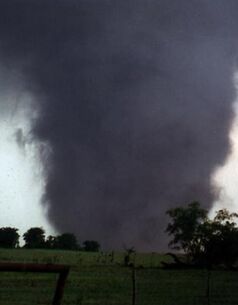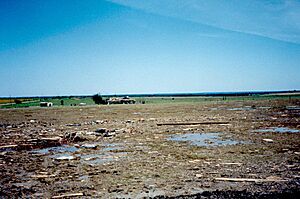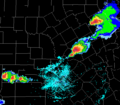1997 Jarrell tornado facts for kids
|
Counterclockwise from top: The tornado at F5 intensity before striking the Double Creek Estates, the radar scan showing the tornado, an aerial view of the tornado track at Double Creek Estates and a mangled car in Jarrell.
|
|
| Meteorological history | |
|---|---|
| Duration | 13 minutes |
| Formed | May 27, 1997, 3:40 pm. CDT (UTC−05:00) |
| Dissipated | May 27, 1997, 3:53 pm. CDT (UTC−05:00) |
| F5 tornado | |
| on the Fujita scale | |
| Highest winds | >261 mph (420 km/h) |
| Overall effects | |
| Fatalities | 27 |
| Injuries | 12 |
| Damage | $40.1 million (1997 USD) |
| Areas affected | Jarrell, Texas and areas near Prairie Dell, Texas |
|
Part of the 1997 Central Texas tornado outbreak and tornadoes of 1997 |
|
On May 27, 1997, a very powerful tornado hit the town of Jarrell, Texas. This tornado was a multi-vortex tornado, meaning it had several smaller spinning columns of air within the main tornado. It caused a lot of damage and sadly, 27 people lost their lives, and 12 others were hurt. The tornado caused about $40.1 million in damages. Many famous photos were taken of this tornado, which led to it being called the "Dead Man Walking".
The tornado moved very slowly over an area called Double Creek Estates. It stayed there for about three minutes with incredible strength, causing some of the worst tornado damage ever seen. Experts have studied this tornado for many years to understand how it caused so much destruction. As of 2024, it is the most recent F5 or EF5 tornado to hit Texas. It was also the fourth deadliest tornado in the United States during the 1990s.
Contents
How the Jarrell Tornado Formed
On the morning of May 27, 1997, weather conditions were just right for strong storms to form in Texas. A low-pressure system in the upper atmosphere moved north, and a cold front stretched across Texas. These conditions helped create a powerful type of thunderstorm called a supercell.
Weather experts from the National Weather Service watched the conditions closely. They saw that the air was very unstable, which is a key ingredient for tornadoes. Later, a special weather balloon showed extremely high values of CAPE. This energy helps storms grow very strong and can lead to tornadoes.
The Storm's Journey to Jarrell
The supercell that created the Jarrell tornado first started in McLennan County. It moved slowly at first. Because of the dangerous weather, the Storm Prediction Center issued a tornado watch for parts of Texas and Louisiana. This means that tornadoes were possible in the area.
As the storm moved, it quickly became stronger. Weather officials issued a severe thunderstorm warning, which was then upgraded to a tornado warning. This meant a tornado was either happening or about to happen. Before the Jarrell tornado, this supercell produced other tornadoes, including an F3 tornado that caused serious damage.
The supercell then moved towards Jarrell. Another tornado warning was issued for Williamson County, which includes Jarrell. This warning came out about 23 minutes before the tornado hit the town. Local sirens in Jarrell went off about 10 to 12 minutes before the tornado arrived, giving people some time to find shelter.
The Tornado's Path and Impact
How the Tornado Started and Grew
The Jarrell tornado officially touched down about 3 miles (4.8 km) north of Jarrell at 3:40 pm CDT. It first appeared as a thin, rope-like funnel cloud surrounded by a lot of dust. The tornado quickly grew stronger and wider, becoming a multi-vortex tornado.
Traffic on Interstate 35 stopped as the tornado came near. Police also stopped traffic, thinking the tornado might cross the highway. However, the tornado moved alongside the interstate but never actually hit it.
As the tornado moved south-southwest, its winds were so strong that they scraped the ground clean. It even ripped up 3 inches (7.6 cm) thick asphalt from three county roads. A recycling plant was completely destroyed, with only twisted metal left. In one sad event, people who had moved from a mobile home to a stronger house for safety were tragically killed when the tornado directly hit the house. The mobile home, however, only had minor damage.
The Devastation at Double Creek Estates
The tornado then turned slightly and entered the Double Creek Estates neighborhood. Here, it reached its strongest point, an F5 rating, and grew to its widest size, about 3⁄4 mile (1.2 km) across. Studies and eyewitnesses said the tornado slowed down a lot here, which made the damage even worse.
For about three minutes, the entire Double Creek Estates area was hit by the tornado's extreme winds. Many well-built homes were completely swept away, leaving only bare concrete slabs. The tornado was so powerful that it even ripped away parts of foundations and plumbing. Grassy fields were scoured up to 18 inches (46 cm) deep. This area was heavily studied because the damage path was so clear.
Cars were picked up, crushed, and thrown over 300 yards (270 m) away. Many cars were never found, likely ground up by the tornado's powerful winds and debris. All the trees in the neighborhood were stripped of their bark. One small tree even had an electrical cord pierced through its trunk.
When the Tornado Weakened and Ended
After leaving Double Creek Estates, the tornado crossed a county road and then moved into a forest of cedar trees. Here, it quickly began to lose strength. It crossed one more road before finally lifting off the ground at 3:53 pm. The tornado was on the ground for 13 minutes and traveled about 5.1 miles (8.2 km).
After the Storm: Recovery and Help
Right after the tornado hit, emergency teams, police, and volunteers rushed to Jarrell to search for survivors and help those affected. Many different groups, like the Texas Department of Public Safety Police and the Texas National Guard, helped with the rescue efforts. Relief operations cost about $250,000, but community donations covered most of these expenses.
The tornado knocked out power in Jarrell, making it hard for people to communicate. Cell phones didn't work, and worried families couldn't reach their loved ones. Emergency services arrived quickly, but the damage was so severe that they almost drove past Double Creek Estates without realizing houses had been there. The Double Creek Estates became the main focus for rescue and recovery.
In the days after the tornado, weather experts studied the damage from the air and on the ground. They confirmed the tornado was an F5, the highest rating for a tornado. Help poured in from all over the country, and millions of dollars were donated to Jarrell.
Texas Governor George W. Bush visited Jarrell and said the damage was "mind-boggling." A temporary morgue was set up by the Jarrell Volunteer Fire Department. Although 30 deaths were first reported, the final number was 27. A memorial park with 27 trees, one for each victim, was built in the Double Creek Estates area. Many people who lived there chose to stay and rebuild their lives in the same community.
Understanding the Fatalities
Out of 131 people living in or near Double Creek Estates, 27 died. Many residents said they knew about the tornado warnings, mostly from TV. Most people watched the tornado approach before taking shelter. They knew to go to the center of their homes and avoid mobile homes. These actions saved lives, but the extreme power of the Jarrell tornado still led to many deaths.
Documenting the Tornado
The Jarrell tornado was well-documented, meaning many photos and videos were taken of it. This made it a very important tornado for weather researchers to study. Videos show its fast rotation and the huge cloud of debris that surrounded it at its strongest.
The "Dead Man Walking" Photo
One of the most famous images of the Jarrell tornado is known as the "Dead Man Walking" photograph. Scott Beckwith took this picture. It became famous because the tornado looked like the grim reaper, a figure that often represents death.
In the photo, the tornado is covered in debris. The main part of the tornado and a smaller spinning part next to it look like "legs" at the bottom, making it seem like a giant walking shape. Another smaller spinning part looks like the blade of a reaper's scythe. This image is just one of eight photos taken as the tornado grew. People often say it's an example of pareidolia, which is when you see familiar shapes in random things. This photo has gained international attention, and the Jarrell tornado made the "Dead Man Walking" nickname popular for other multi-vortex tornadoes that have similar "leg" shapes.
What Was Damaged?
Buildings and Homes
In the Double Creek Estates, 38 buildings were completely destroyed. Three businesses next to the Estates were also ruined. The tornado caused an estimated $10 to $20 million in damage just to that neighborhood.
Overall, the tornado destroyed about 40 family homes. Many of these homes, especially in Double Creek Estates, were completely swept off their foundations by the wind. The damage was rated F5, the highest level, along most of the tornado's path. In total, about $40 million in property damage occurred, and another $100,000 in damage was done to crops.
Responses to the Disaster
Then-Governor of Texas, George W. Bush, declared Williamson County a disaster area. During his visit to Jarrell on May 28, he said it was "the worst tornado I've ever seen." U.S. Senator Kay Bailey Hutchison also visited the area. Governor Bush later asked for federal help for Williamson and Bell counties.
However, the Federal Emergency Management Agency (FEMA) decided not to provide federal aid. They said that enough money was coming from private donations and state sources. Instead, the Small Business Administration and the U.S. Department of Agriculture offered loans to help people rebuild their homes, farms, and ranches.
From May 29 to June 1, weather experts and the Texas Wing Civil Air Patrol flew over and walked through the damaged areas to map out the tornado's path and assess the destruction.
See also
- List of North American tornadoes and tornado outbreaks
- List of F5 and EF5 tornadoes
- List of disasters in the United States by death toll
- 1999 Bridge Creek–Moore tornado – another extremely powerful F5 tornado that hit Oklahoma in 1999
- 2007 Elie tornado – another F5 tornado in 2007 that moved slowly and had an unusual path
- 2011 Smithville tornado – a fast-moving EF5 tornado that caused extreme damage, similar to the Jarrell tornado
- 2011 Joplin tornado – an EF5 tornado in 2011 that caused similar damage patterns
Images for kids














